Menu
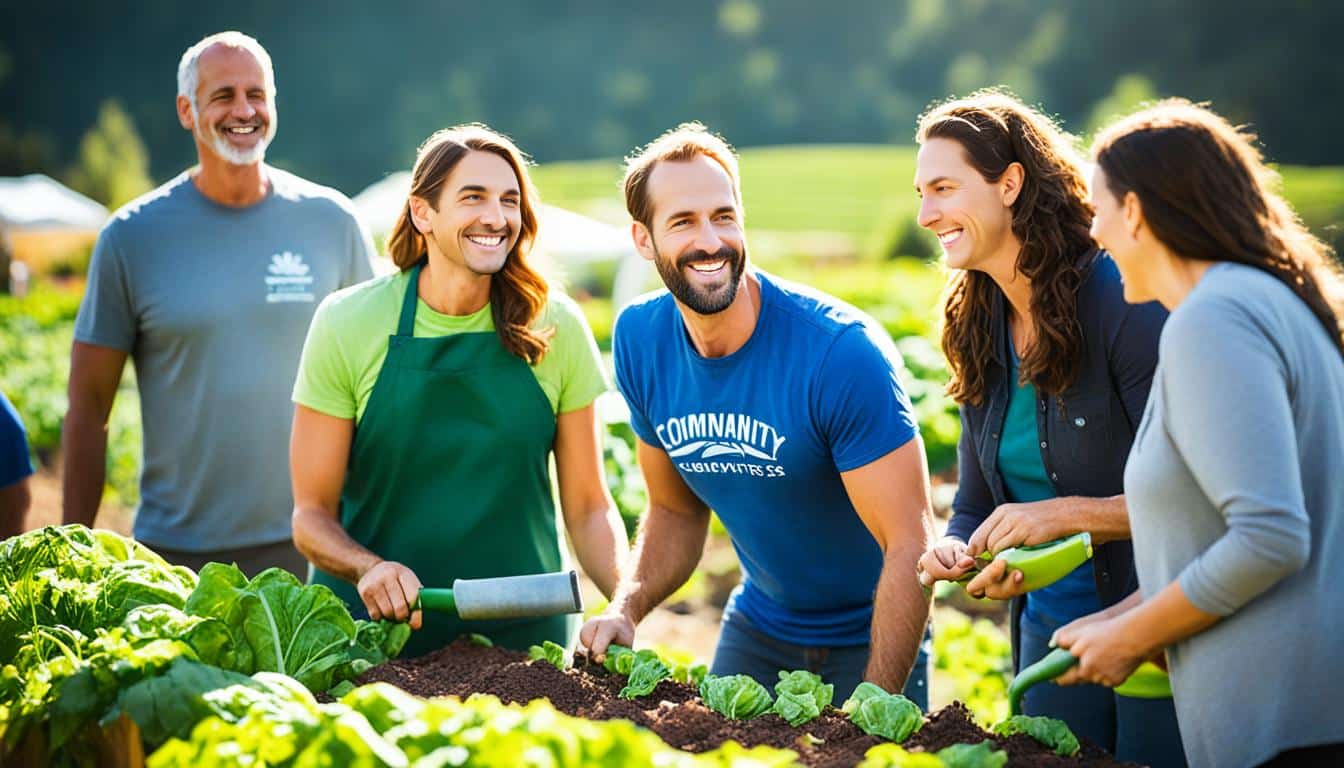
Did you know that only one in ten adults in the U.S. eat enough fruits and vegetables? Community-Supported Agriculture (CSA) steps in as a great, fresh, and eco-friendly answer. It’s interesting that all CSA members say they get top-quality, fresh, and nutritious food. They also get to know the producers, discover new types of food, and feel part of a community.
CSA is not just about the food; it helps local food systems grow and brings economic gains. When people join a CSA, they connect directly with the growers. This means they know where their food comes from and they help the local economy. They get regular deliveries of fresh, healthy food, straight from the farm. This food tastes great and is full of nutrients because it’s just been picked.
CSAs have changed to meet different people’s needs. They now offer a range of package sizes and ways to customise what you get. You can also choose when and how you get your food. This makes CSAs more appealing and lets people learn about farming. They get to try new foods and join a group that cares about the environment and good eating.
Community-Supported Agriculture (CSA) brings folks closer to local farmers. It’s a way for people to get fresh, seasonal goodies while supporting local farm incomes. Those in a CSA invest in not just their health but also in supporting the local food system.
This support helps the agriculture community and boosts the local economy.
CSAs create a strong bond between farmers and consumers. The model works like this: people pay a set fee at the season’s start for a share in the year’s produce. This price can vary but is often between $400 and $700. Sometimes, options like half shares exist.
Members then get a regular supply of fresh seasonal produce right from the local farms.
The CSA idea started in the 1980s in the United States. It began at two farms, Indian Line Farm in Massachusetts and Temple Wilton Community Farm in New Hampshire. The concept’s roots can be traced back to “Clientele Membership Clubs” started by Dr. Booker T. Whatley.
CSAs have grown a lot since then, supporting local farming and encouraging international connections. The model has greatly increased the number of farms involved, according to the United States Department of Agriculture. This shows its importance in building strong local food systems.
CSAs have shown they can change and grow to meet more people’s needs. Every season, they can get new members and often have waiting lists. North Carolina alone has about 100 CSAs, and this number keeps going up. Even with the rise of the internet, CSAs are finding new ways to connect with more people.
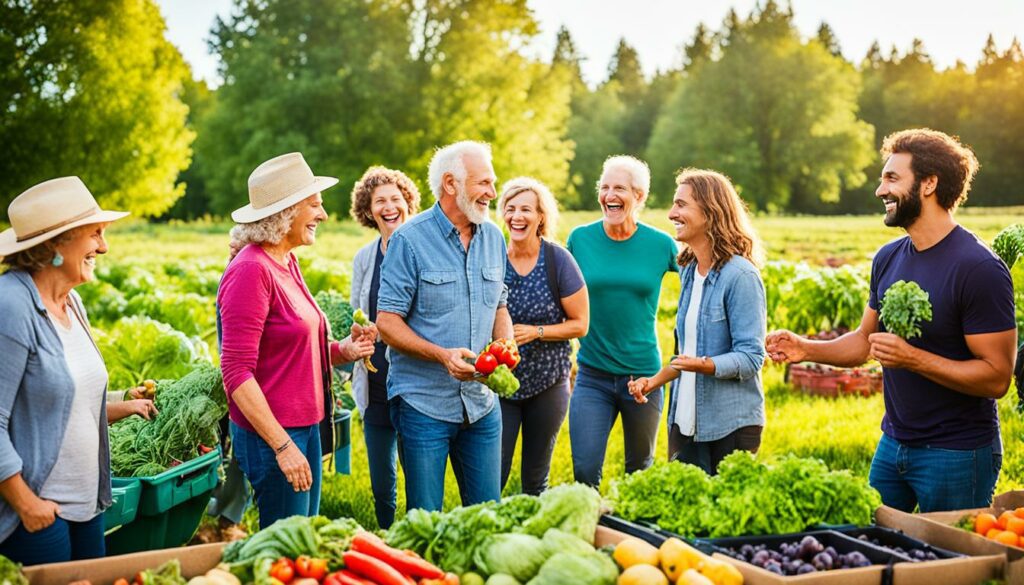
Both farmers and consumers love the honesty and teamwork of the CSA model. It’s different from traditional shopping because everyone agrees to share in the success but also in the challenges, like if a crop fails. This agreement helps farmers earn a steady living, and it means people can count on getting fresh food.
Today, CSAs are still changing, guided by talks among marketing experts and the success of different platforms. They remain key in the farm-to-table movement, uniting consumers and producers in a passion for healthy, sustainable living.
Community-Supported Agriculture (CSA) models help a lot. They make sure farmers can keep going and help customers trust the products. This boosts the whole farming system in exciting ways.
CSAs provide farmers with stable incomes. This means they can earn more without needing loans. For example, giving SNAP users a 75% incentive will help at least 750 families buy a CSA share by 2024.
With 25 CSAs over 4 years, each with 30 members, this brings steady money to farmers. It also helps 125 SNAP families keep buying CSA shares. This ongoing support makes the local food market stronger.
CSAs work on trust by being clear about how they farm. This helps customers know their food is safe. Groups like the California Alliance with Family Farms help with advice, while Local Harvest supports farmers. This makes sure customers believe in what they’re eating.
More than a quarter of CSA members will likely eat more fruits and veggies because of this trust. True information leads to healthier eating and tighter-knit communities.
Projects like Farm to Family are making a big difference. They want to grow from 4 to 8 communities in 4 years. By working together, local programs can do more. They help farmers earn more and people trust food more.
Community Supported Agriculture (CSA) means you get top-quality, fresh produce. Its system lets you receive food within hours of harvest. This way, you enjoy food at its best, rich in nutrients which are great for your health. 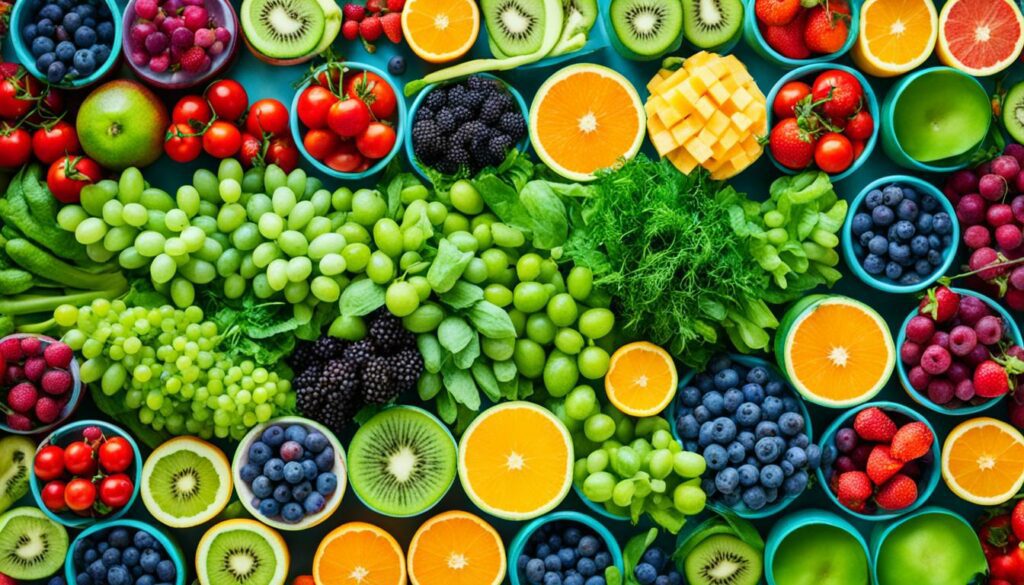
CSAs are all about bringing you fresh, often organic, produce. The demand for organic food is high, hitting $5.6 billion in sales in 2019. People want food that’s good for them and grown without harmful chemicals, and this concern is growing.
CSA food outshines supermarket produce in quality. You get a wide range of fresh, tasty farm foods that keep you healthy. By choosing CSA, you also help the planet. Less transport and packaging waste means fewer greenhouse gas emissions.
CSAs offer everything from usual fruits and veg to special heirloom varieties. This choice means you eat a wide range of nutrients, which is great for your health. Plus, it’s all about being organic. These factors make CSAs the better pick for those caring about health.
The CSA model works by consumers buying into a share of the farm’s produce for the season. Members get fresh, local produce delivered regularly. This connects consumers directly to the farmers.
CSA costs and structures differ depending on the region. In North Carolina, CSA shares mostly range from $400 to $700 a year. Some farms there offer half shares which are priced differently from what you’d expect.
While it seems a lot at first, this approach helps farmers. It lets them plan their seasons well and guarantees a steady supply of food. This food is often better for you, grown with fewer pesticides and synthetic fertilisers. It also means farmers have a safety net from market changes.
CSAs have become more flexible over time, making them more popular. They now offer various share sizes to fit different family needs. You can choose from smaller portions for singles to larger packages for families.
There are also more ways to get your produce. You can pick it up weekly or every other week. Or, you might be able to have it delivered to your home. These choices make CSAs more convenient for everyone.
CSAs also offer payment plans for those with lower incomes. This shows how the system aims to be inclusive and supportive of all. It ensures more people can access and enjoy fresh, healthy, locally-grown food.
Here’s a look at the costs and payment options for CSA shares in a table:
| Share Type | Annual Cost (USD) | Payment Plans |
|---|---|---|
| Full Share | $400 – $700 | Available in most farms |
| Half Share | More than half the cost of a full share | Available in select farms |
Community Supported Agriculture (CSA) supports sustainable farming. It is good for the environment, leading to less waste and a smaller carbon footprint. Choosing CSA means getting fresh food while supporting farming that cares about our Earth.
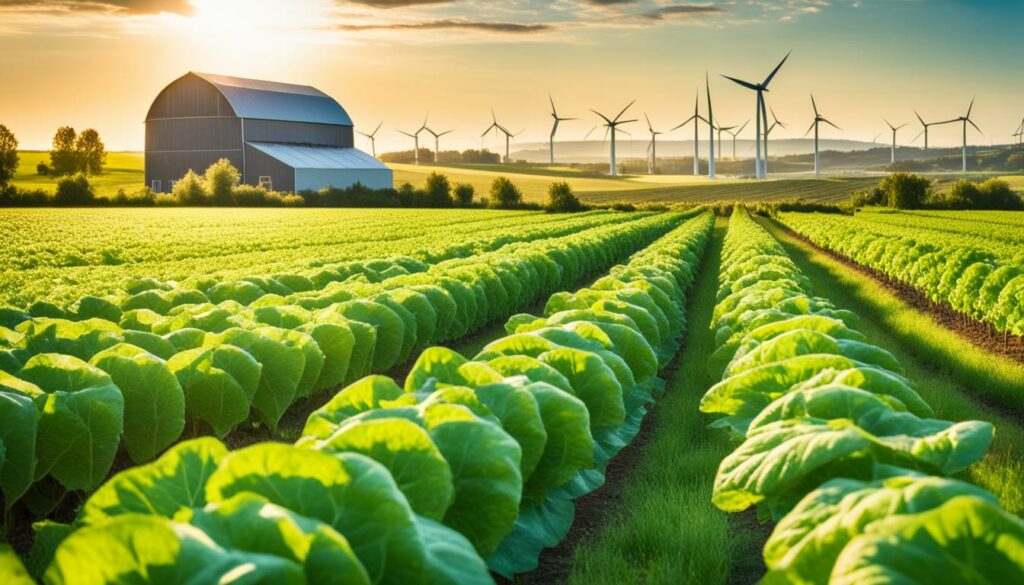
CSA farms use eco-friendly methods. They aim to reduce waste and use less packaging. This helps the environment by lessening the impact on our planet.
CSA is all about being eco-conscious. It lowers harmful emissions by using less transport and eco-friendly farming. Many CSAs in the United States work sustainably. They offer various food items while keeping the Earth healthy.
| Aspect | Impact |
|---|---|
| Sustainable Agriculture | Encourages organic farming practices and reduces chemical usage |
| Eco-Friendly Consumption | Minimises packaging and promotes green living |
| Low Carbon Food | Local distribution cuts down transportation emissions |
Choosing CSA means fresher food on our tables. It also means supporting farms that care about the future. Over 2,500 CSA farms in the United States show we can eat well and support the planet at the same time.
The Community-Supported Agriculture (CSA) model strengthens the link between consumers and producers. It enhances a healthy relationship based on trust and shared benefits. Typically, CSAs in the US cost between $400 and $700 per year. For this price, members get fresh vegetables every week. Over 2,500 CSAs connect with communities across the US, with over 100 operating in North Carolina alone.
CSAs work hard to be affordable for everyone. They offer payment plans and donate shares to those in need. Members can choose between full or half shares. A half share usually costs a bit more than half the price of a full share. Some members even help out on the farm in exchange for a discount.
Still, CSAs sometimes struggle to keep members. They can lose anywhere from 25% to 70% between seasons. To keep people interested, CSAs hold events and offer educational resources. These activities shift the focus from supermarkets to local farms, helping visitors understand and value them more.
The connection in a CSA goes beyond buying and selling. It builds a close-knit community dedicated to supporting sustainable agriculture. Through this community-driven approach, consumers and producers together ensure the success of local farming. This is good for the planet and the area’s economy.
| Aspect | Details |
|---|---|
| Annual Membership Cost | $400-$700 |
| Number of CSAs in the US | Over 2,500 |
| CSAs in North Carolina | Over 100 |
| Weekly Produce Variety | Freshly picked vegetables |
| Payment Plans | Available for low-income members |
| Member Contribution | Work-share memberships offered |
| Member Turnover Rate | 25-70% lost each season |
| Retention Improvement | On-farm activities and member education |
| Community Engagement | Promotes local resilience |
Eating food that’s in season is more exciting through Community Supported Agriculture (CSA). It lets you try different fruits and vegetables. Yet, there are problems like produce not being available all year round.
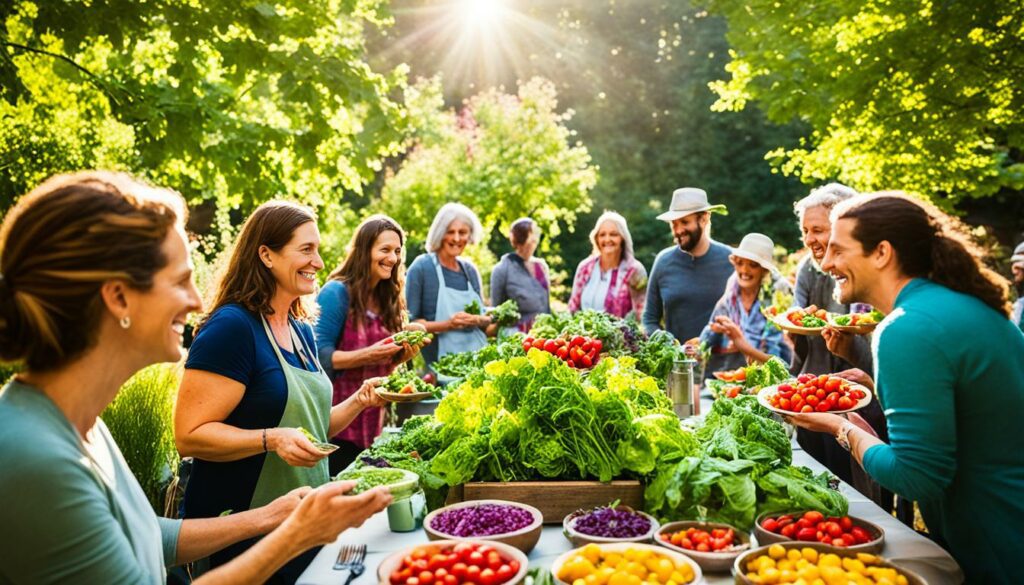
Seasonal eating introduces people to new and exciting produce. CSA members get to enjoy agricultural diversity. They have the chance to eat various fruits and veggies not easily found elsewhere. This mix not only adds variety to meals but also makes them more enjoyable.
Getting into seasonal eating requires flexibility. Produce comes and goes with the seasons, making meal planning a bit more challenging. But, this challenge also brings excitement. It encourages people to eat what’s fresh, which is usually at its peak nutrition. This way, they benefit from the best nutritional value available.
Choosing to eat seasonally helps us get the nutrients we need at the right times. This boosts our health and improves our diet. It’s all about working with nature’s schedule for better nutrition.
Being part of Community-Supported Agriculture (CSA) is more than getting fresh food. It includes events and farm visits. This deepens connections within the community. It also helps in growing the local economy. Projects in places like Montana get big support from SARE grants, thanks to community involvement.
It’s key to build strong community relationships. Sharing values forms strong bonds. CSA events let people meet farmers and see how food is grown. This boosts knowledge about farming sustainably. It also makes the food chain more transparent, building trust.
Farm visits and events are common in CSAs all over North America. With over 13,000 CSAs, these events are vital for community education and involvement. They’re fun for families too, making great memories. Women play a big role in leading these activities within CSAs.
Let’s look at some numbers to understand the reach:
| Country/Region | CSA Farms |
|---|---|
| United States | 12,549 |
| China | 500+ |
| Switzerland | Multiple under Solawi model |
| Italy | Notable examples: C.A.P.S. and Arvaia |
Local events and farm visits show the benefits of buying local. Just shifting 15% of out-of-state food to local in Montana could boost farmer income by $134 million. These actions really help local economies and make farming stronger.
In the end, taking part in CSA events and farm visits helps everyone. It brings consumers and farmers closer, benefiting the local community a lot.
Community-supported agriculture (CSA) programmes are vital in the farm-to-table way. They link local farmers straight with buyers and companies. This link is a win for farms and brings fresh goods to local eateries.
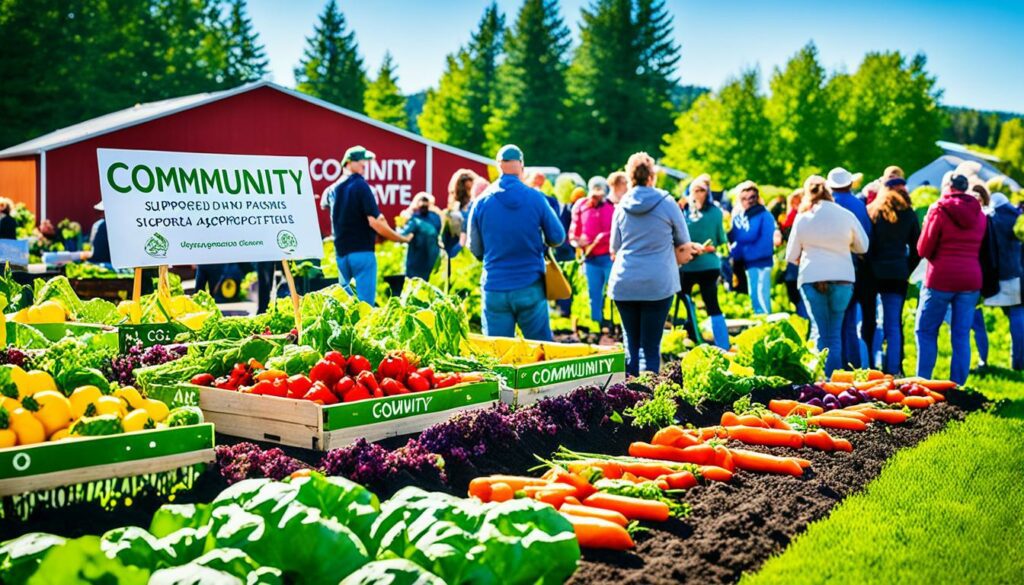
The teamwork between CSAs and local spots changes things. When they work together, farmers send out fresh picks to restaurants quickly. This means better food quality in places to eat, showing their strong support for farm-to-table ways.
CSAs hugely affect local diners. Chefs get a set supply of the latest seasonal goods. This change adds variety to what they cook and helps the environment. In places like Texas, many CSAs join hands with eateries, promoting fresh foods. This helps restaurants support local farms and eco-care. It’s a way to keep the local area rich and green.
Ensuring CSA affordability and giving access to fresh food are key to food justice in our spaces. Community-supported agriculture (CSA) schemes have come up with flexible payment choices.
This makes it simpler for people from all financial situations to join in.
The sliding scale method boosts payment flexibility. It lets people pay based on what they earn, thus broadening CSA’s reach. Uprising Organics in Washington offers SNAP users three payment levels. Their weekly costs vary from $10 to $20.
In a similar way, the Solidarity Food Network in Van Etten, NY, helps families that earn less than $20,000 a year. They let these families pay their CSA fees in $30 monthly bits.
| CSA Program | Location | Sliding Scale Payment Details |
|---|---|---|
| Uprising Organics | Washington | $10 – $20/week for SNAP recipients |
| Solidarity Food Network | Van Etten, NY | $30/month for incomes under $20,000/year |
| Canticle Farm | Allegany, NY | $85 – $640 with loan funds and working share programs |
Many CSAs have come up with creative ways to help low-income households. The Chelsea Community CSA got a $4,000 grant. They put it towards a loan fund for their low-income members.
Also, Canticle Farm in Allegany, NY, offers CSA packs from $85 to $640. They include loan funds and work share programmes. This makes fresh food more affordable and accessible.
CSAs are really pushing ahead to make food justice a reality. Their flexible payment structures welcome everyone to enjoy fresh, healthy, local foods, no matter their financial state.
The Community-Supported Agriculture (CSA) model has some challenges. These include keeping members and being financially stable. Many CSAs are finding new ways to tackle these problems.
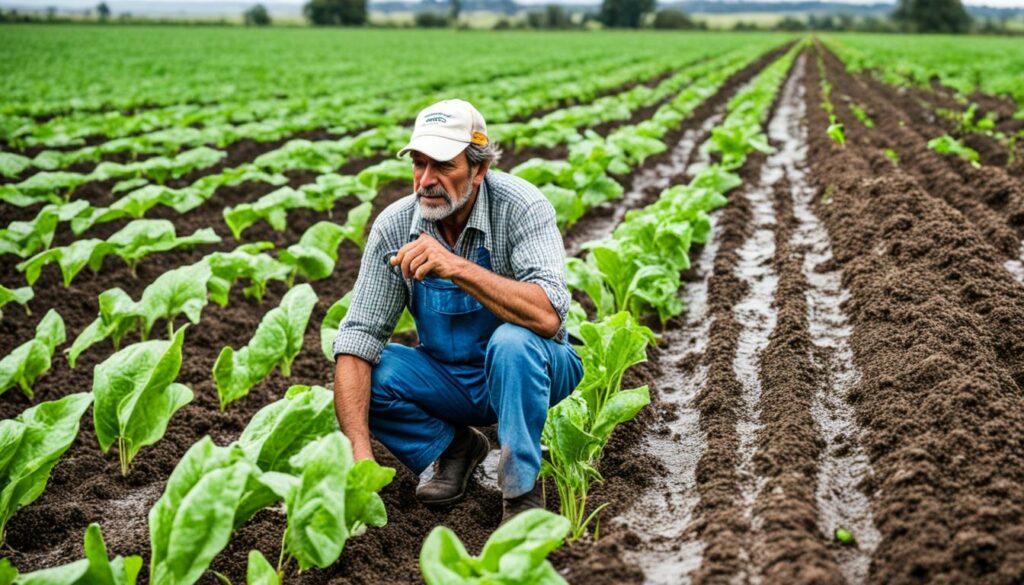
Keeping members can be hard for CSAs. Each season, they might lose 25-70% of their members. To keep people interested, CSAs hold activities like workdays, parties, and learning sessions. This makes everyone feel more a part of the group.
Some CSAs let members work on the farm instead of paying. This work-share idea helps out financially and gets people more involved. Also, after the season, CSAs ask for feedback. This helps them get better at what they do and meet the members’ wishes.
For farmers, staying financially sound can be tough. The ‘pay first, then get produce’ system helps at the start of the season. But, it can be risky if crops fail or prices fall.
CSAs try new ways to sell their produce to lower the risk. They might offer different share sizes or sell more than just vegetables. In North Carolina, for example, many CSAs sell a variety of products to stay afloat.
Using online spaces and social media helps CSAs reach more people. They can also use sliding scales for payments. This makes sure that everyone can buy their fresh food, even those with less money.
With smart plans for keeping members and selling their goods, CSAs can thrive. They help keep local food available and support the farmers in their community.
In the last 25 years, Community Supported Agriculture (CSA) has become very popular. People can buy seasonal, local food directly from farmers through CSAs. To start, look for a CSA that meets your needs. Many resources can help you find one.
LocalHarvest’s CSA directory is a great place to start. It lists over 4,000 CSA farms in the USA. This shows how big the interest in local food is. It’s easy to find local CSAs there. You can also use apps like GrownBy to find and buy from farms nearby.
Visiting CSA fairs or talking to extension programs, like those offered by Michigan State University, can offer great advice. Remember, some areas might have more people wanting CSAs than there are available spots. This shows how much people like community agriculture.
When you pick a CSA, think about what they offer, such as vegetables or special items like cheese or flowers. Also, check if they have small share sizes or offer trial subscriptions. This way, you can try out a CSA without a big commitment.
It’s also key to understand how to pay and where to pick up your food. Farms usually have many pick-up spots and times. Some might even deliver to your home for an extra cost. But, choosing home delivery might lessen the direct farm connection you get with a CSA.
Look into how the farm grows its food. Choosing farms with practices like USDA organic can mean better food quality and support for eco-friendly farming.
Searching on Google for terms like “organic farms near me” and checking Google Reviews can help you pick the right CSA. This makes sure you choose one that fits your food choices and values. It helps support the community agriculture idea.
Community-Supported Agriculture (CSA) has many key benefits. It helps us live in a way that is good for the planet and our health. In the U.S., where many people struggle to get enough food, CSAs are a big help. They bring fresh, healthy food right to people’s doors. Many believe this food is more trustworthy than just anything that says it’s organic. This trust helps local farmers and builds strong communities focused on open, caring farming.
CSA farming means a lot to both the farmers and those who eat the food. Studies have shown that taking part can improve how people cook and feel about their cooking skills. Amazingly, these benefits last a long time, showing that CSA supports not just health right now but for the future too. This is especially important in a world where many are not getting enough to eat.
CSAs offer a green alternative to big farming that harms our planet and well-being. They link those who grow food with those who eat it. This helps keep money and jobs in the community, keeping rural places alive. For example, in Boulder County, family farms do well thanks to these CSA shares. They show us a better way to face the world’s food problems.
To sum up, CSAs are incredibly important. They promote a way of living that is good for all of us. By working with governments and local groups, CSAs can do even more good. The focus on working together in a fair way shows how powerful CSAs are. They are essential for making our food system strong and caring.
Community-Supported Agriculture (CSA) connects people with local farmers. It provides fresh food all year. This direct link offers farmers steady pay and buyers high-quality produce.
Joining a CSA means getting fresh, healthy food and supporting local farmers. It helps the environment by using sustainable farming. Members also enjoy feeling part of a community.
The CSA model has changed to meet the needs of customers. It offers different share sizes and ways to get your food. Now, you can even sign up online and find advice about marketing and sales tactics.
CSAs help farmers earn a steady income with a ready market. This means farmers don’t have to rely on loans as much. It supports their business, making farming more secure.
By showing how food is grown and made, CSAs gain customers’ trust. This open approach makes people confident in the food’s quality and the way it’s produced.
CSA produce is fresh because it’s harvested shortly before it gets to you. This means it’s very nutritious and tastes great, promoting good health among consumers.
CSAs use less packaging and transport food locally. They farm in ways that protect the earth, aiming to lower their environmental impact. These help preserve the planet and its resources.
CSAs back farming that is kind to the environment. They reduce their carbon footprint by using sustainable methods. This choice leads to a healthier food system.
CSAs bring people and farmers closer together. By visiting farms or talking to farmers, buyers understand more about how their food is grown. They get involved in their local food production.
Eating seasonally means trying new foods and flavours. It’s exciting for your meals. But, it can be challenging because not all foods are available all year round.
CSAs host events like farm tours, which let people see where their food comes from. It makes members feel more part of their local farming community.
CSAs are key in serving local, fresh food to restaurants. They form partnerships that support the local economy and promote sustainable eating habits.
CSAs give choices like sliding scale payments to help more families afford fresh food. This means even families on a tight budget can enjoy healthy, local meals.
Keeping members and staying economically sound are tough tasks for CSAs. They use social media and innovative payment options to keep members coming back. It helps them stay in business.
Look for CSAs through Local Harvest, CSA fairs, or university programs like those at Michigan State. These resources connect you to CSAs in your area.